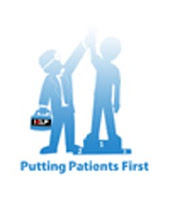Health literacy incorporates a range of abilities: reading, comprehending, and analyzing information; decoding instructions, symbols, charts, and diagrams; weighing risks and benefits; and, ultimately, making decisions and taking action. The concept of health literacy also extends to the materials, environments, and challenges specifically associated with disease prevention and health promotion.
TIPS FOR USING PLAIN LANGUAGE:
Certain qualities characterize plain language. These include common, everyday words, except for necessary technical terms. Other qualities include the use of personal pronouns; the active voice; logical organization; and easy-to-read and understand design features, such as bullets and tables.
1. Engage the reader.- First, consider who the reader is. Often, there is more than one reader.
- Consider what the reader needs to know. Organize content to answer the reader's questions.
- Write for the appropriate reading level.
- Word Choices:
- Use common, everyday words
- Use other personal pronouns such as "you"
- Use "must" instead of "shall"
- Avoid using undefined technical terms
- Use positive rather than negative words
- Avoid using gender-specific terminology
- Avoid long strings of nouns
- Verb Forms:
- Use active voice
- Use action verbs
- Use the present tense
- Structure:
- Use parallel construction
- Be direct
- Avoid using unnecessary exceptions
3. Display Material Correctly
Appearance is an important aspect of clear communication. If a document is pleasing to the eye, it will be more likely to attract your reader's attention. Appearance can also be an aid to the reader, improving comprehension and retention. There are four main aspects of appearance:
- Organization. Strong, logical organization includes an introduction followed by short sentences and paragraphs. Organize messages to respond to reader interests and concerns.
- Introduction. In lengthier documents, use an introduction and a table of contents to help the reader understand how a document is organized.
- Short sentences and paragraphs. Sentence length should average 15-20 words. Sentences that are simple, active, affirmative, and declarative hold the reader's interest. Generally, each paragraph should contain only one topic. A series of paragraphs may be used to express complex or highly technical information. The more writing deviates from a clear and to-the-point structure, the harder it will be for the reader to understand what is being conveyed.
- Layout. Layout includes margins, headings, and white space. Provide white space between sections to break up text and to make it easier for readers to understand. Use headings to guide the reader; the question-and-answer format is especially helpful. Try to anticipate the reader's questions and pose them as the reader would. Use adequate margins.
- Tables. Tables make complex information readily understandable. Tables can help the reader see relationships more easily. They may require fewer words than straight text.
- Typography: Typography relates to fonts and typographical elements used for emphasis, such as bullets or italics.
4. Evaluate Your Document
To ensure that you are communicating clearly, evaluate the document or have another person read it and offer suggestions for clarification. Look over the document for:
- Correct spelling, grammar, and punctuation;
- Inclusion of appropriate devices, such as dating, page numbering, and consistency;
- Visual appeal;
- Consistency and effectiveness of layout and typographical devices (avoid overuse); and
- Line breaks that inadvertently separate part of a name or date in a way that reduces clarity.




1 comment:
I agree, plain English makes speaking and writing easier to understand and read.
marble tile collier county
Post a Comment